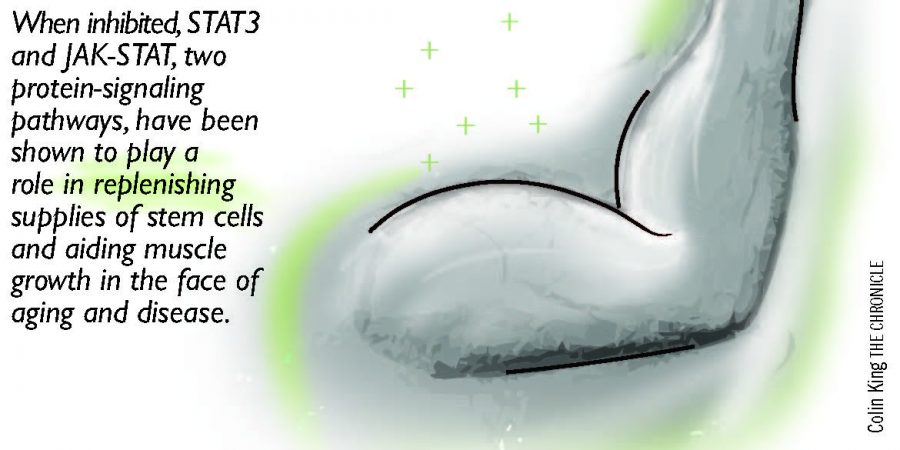Stem cell studies signal new brawn in muscle maintenance
Stem cell studies signal new brawn in muscle maintenance
September 15, 2014
Like most components that make up human biology, stem cells lose steam over time. However, in two new studies scientists may have found ways to keep them replicating and functional for longer. These findings could lead to novel treatments in both age- and disease-related muscular degeneration.
The two papers, published alongside one another on Sept. 7 in the journal Nature Medicine, each focused on a different signaling pathway—a series of proteins that transmit signals from outside of a cell to the inside of a cell—affecting the regeneration of stem cells in skeletal muscle. One of the three major muscle types in the body, skeletal muscle is affected by aging and degenerative muscle-wasting diseases like muscular dystrophy, a genetic mutation expressed in every one in a few thousand male births, according to the National Institutes of Health.
To maintain skeletal muscle, whether in the face of aging or a degenerative disease, there are two main processes that need to happen, according to Alessandra Sacco, an assistant professor at the Sanford-Burnham Medical Research Institute where one of the two studies was performed.
“There is a need to have stem cells within the tissue that can actually repair the injured muscle when damage occurs,” Sacco said. “The [second process] is that these cells need to be able to generate mature muscle and differentiate into muscle fibers.”
Differentiation is the process by which, when a stem cell divides, one of the copies specializes and enters the early stages of becoming a new kind of cell—in this instance, a skeletal muscle cell. Sacco’s team looked at a signaling protein called STAT3, which is released by cells in response to injury and can trigger the expression of certain genes related to the early development of muscle fiber. STAT3 has been shown to sometimes aid in the regeneration of tissue and at other times hinder it.
Sacco said that in the case of muscular dystrophy, gene mutation makes muscle cell membranes very fragile. Over time these fragile fibers are easily damaged and require almost constant repair. After undergoing several cycles of degeneration and repair, stem cells become progressively more exhausted and are less effective at healing damaged tissue. Those who suffer from the disease can experience an inability to relax their muscles, difficulty with basic motor function and severe impairment.
“Our goal was to try to understand whether a specific pathway like STAT3 could act selectively and tip the balance between those two processes,” Sacco said.
When researchers introduced the inhibitor, made from molecules that bind to STAT3, they found that this binding prevented the protein from activating genes within the nuclei of cells that could otherwise suppress stem cell growth and the formation of new skeletal muscle tissue. Suppressing this pathway could help expand the muscle’s supply of stem cells and build new muscle fiber more efficiently.
According to Alessandra Castiglioni, a post-doctoral fellow at Harvard University’s Stem Cell Institute, when there is injury in a skeletal muscle, immune cells are recruited to the site of the inflammation to clear debris from the damaged muscle fibers. The immune cells then begin to create an environment in which stem cells can begin the process of building new muscle. These stem cells have the ability to divide to create building blocks for new muscle fibers or to give rise to more stem cells that can be set aside for later use.
“When a body or an organism ages, the normal physiology is altered and you start to lose muscle,” Castiglioni said. “One reason for this is that the stem cells are not able to continue reconstituting their supply so their numbers and functionality reduce with age.”
Michael Rudnicki, a senior scientist, director of the regenerative medicine program at the Ottawa Hospital Research Institute and lead researcher for the second study, said his team isolated muscle stem cells from mice of varying ages and inserted them into younger mice to assess how their function declined with age. The researchers identified the activation of the so-called JAK-STAT pathway, which directs stem cells to divide and preferentially make new muscle fiber rather than replenishing stem cell reserves, as one of the major changes that occurs as with age.
“We found that this JAK-STAT pathway [has an influence] on this very early decision-making process,” Rudnicki said.
When researchers applied a drug or genetic approach to inhibiting the activation of JAK-STAT, muscle stem cells regained their renewal and repair abilities.
Rudnicki said a stem cell can divide in a variety of ways. It can give rise to two cells that are both dedicated to the development of new tissue, in which case the body’s supply of muscle stem cells depletes as the two new cells are redirected to build tissue rather than replenish reserves. A stem cell can also divide and produce two cells that are both stockpiled for later use, or one cell can be dedicated to each cause.
The discovery of a way to inhibit the activation of the JAK-STAT pathway, and in turn determine which way stem cells will divide and how those new cells will be used, could help address the muscle deterioration that occurs with age.
“I think stem cell research is paving the road for regenerative medicine to enter the clinic,” Rudnicki said. “We’re arriving at a tilting point where, within our lifetimes, we’re going to transform the practice of medicine. If we can identify drugs that target and mobilize these cells in a specific way, then we will be able to greatly enhance the treatment of diseases for which we don’t have any treatment at this time.”








